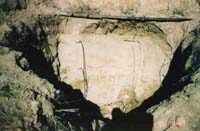Minnesota Water Science Center

Bemidji Crude-Oil ProjectMinnesota PROJECTSUSGS IN YOUR STATEUSGS Water Science Centers are located in each state. 
|
Background InformationTable of Contents:
IntroductionOn August 20, 1979 approximately 16 kilometers northwest of Bemidji, Minnesota, the land surface and shallow subsurface were contaminated when a crude-oil pipeline burst, spilling 1,700,000 L (liters) of crude oil onto a glacial outwash aquifer (fig. 1). After cleanup efforts were completed 400,000 L of crude oil remained. The site was selected for study by the Office of Hazardous Waste Hydrology of the U.S. Geological Survey in 1982. Research began at the site in 1983. Characteristics of the site that make it suitable for long-term, interdisciplinary study include the following: (1) the introduction of a source of uniform composition at a known place and time, (2) the absence of other sources of contaminants, (3) a simple hydrogeologic setting that is susceptible to ground-water contamination and is representative of many other toxic waste sites, (4) the presence of three fluid phases (oil, water, and air), (5) the low potential for harmful effects to humans owing to the remoteness of the area and the sparse population, (6) the absence of human- induced hydraulic stresses such as pumping wells and irrigation, and (7) the low toxicity of crude oil compared to other hazardous wastes. Purpose and ScopeDescription of the SiteHistory of InvestigationsSome of the crude oil infiltrated the ground and percolated to the water table. Some petroleum compounds and degradation products have been dissolved by ground water and transported downgradient. Volatile constituents have diffused through the unsaturated zone. By 1992, liquid petroleum had moved as a separate fluid phase about 30 m in the direction of ground-water flow, constituents dissolved in the ground water had moved at least 200 m, and vapors in the unsaturated zone had moved horizontally about 100 m (Hult, 1991). Spatial differences in the physical properties and composition of the oil have developed owing to alteration of the originally uniform source. The oil is selectively losing soluble and volatile compounds through dissolution and vaporization. Annual oil-mass loss rates of the crude oil source at different locations range from 0 to 1.25 percent and total accumulated losses from the original oil mass are as much as 11 percent (Landon and Hult, 1991). Most of the petroleum derivatives moving as solutes and vapors are being degraded by biologically mediated processes to carbon dioxide, water, and methane (Baedecker and Cozzarelli, 1991). The aquifer is being altered through dissolution and redeposition of silicate materials (Bennett, 1989). The U.S. Geological Survey Toxic Substances Hydrology Program has held five technical meetings since 1984 with plenary sessions at which the status of research at the site was summarized. Results of the project have been published in proceedings of these technical meetings (Hult, 1984a; Franks, 1987; Ragone, 1988; Mallard and Ragone, 1989; Mallard and Aronson, 1991; Morganwalp and Aronson, in press), in proceedings of other conferences, and in scientific journals. Smith and Hult (1993) present location and altitude data for selected features at the research site, water and oil level records from selected observation wells, and geologic information from 45 test holes collected from 1983 through 1991. Composition of the OilMolecular composition. In 1987 oil was collected from the approximate center of the oil body (wells, 421 and 301) and at its leading (well 534) and trailing (well 604) edges. Despite the fact that the four oils were obtained from different areas of the oil body at locations spanning its complete length along one axis, their molecular compositions were essentially identical. Moreover, the detailed composition of an oil sample obtained from the pipeline company after the spill was indistinguishable from that of the four oil samples taken from the oil body. The crude oil is dominated by saturated hydrocarbons (58-61%), with aromatics representing most of the remainder (33-36% of total oil). Resins, which include N-, S- and O-containing (i.e. NSO) species, comprise ~4-6% of the total, whereas asphaltenes are only a minor component (1-2%). These distributions are typical of normal crude oils, and according to the classification scheme outlined by Tissot and Welte (1984), the Bemidji oil would be designated as either a paraffinic or paraffinic-napthenic crude oil. The dominant hydrocarbons are normal alkanes (C6-32). These compounds occur as an homologous series with the higher molecular weight species (i.e. >C10) maximizing at either n-C14 or n-C15 and exhibiting little or no odd-even chain length predominance (Baedecker et al., 1984). The second most abundant class of hydrocarbons is the regular acyclic isoprenoids (i.e. C10, C11, C13-16, C18-21). The C19 isoprenoid, pristane (2,6,10,14-tetramethylpentadecane), is the most prominent member. Most of the alicyclic hydrocarbons are chromatographically unresolved using the conditions described here. However, cyclohexane and a series of n-alkyl substituted cyclohexanes occur in minor amounts (C2-20-cyclohexanes). Tetracyclic steranes, tricyclic diterpanes and pentacyclic triterpanes (commonly found in crude oils and ancient sediments), if present, were not detected under the analytical conditions used. The majority of the aromatic hydrocarbons are observed on gas chromatograms as an unresolved complex mixture (Baedecker et al., 1984). However, benzene + C1-5 alkylated benzenes are important constituents of the crude oil, and naphthalene + C1-6 alkylated homologs and phenanthrene + C1-5 alkylated homologs are the most abundant resolved polycyclic aromatic hydrocarbons. In the latter two series, the monomethyl species dominate the alkyl homolog distributions, a patter typically observed for crude oils (Youngblood and Blumer, 1975) No sulfur heterocyclic compounds (.e. benzothiophene, dibenzothiophene + alkylated homologs) were found in the Bemidji oil samples despite the fact that alkylated thiophenes were identified in contaminated groundwater near the oil body using purge-and-trap HRGC/MS. The high aqueous solubilities of these heteroatomic molecules (Price, 1976) may account for this apparent discrepancy. Thorn and Aiken (1989) and Thorn (1987 pers. commun.) have shown that crude oil samples collected in 1987 from wells 301, 421, 534, and 604 exhibit quantitative liquid phase 13C-NMR spectra that are identical. The oils show strong absorption peaks in the 0-60 ppm (aliphatic) region and lesser peaks at 100-160 ppm (aromatic). The integrated peak area corresponding to aliphatic carbons represents 83% of the total with aromatic carbons being 17%. Distortionless enhancement by polarization transfer NMR spectra for the Bemidji crude oil demonstrates that methylene carbons exceed in abundance either the methine (indicative of branching) or methylcarbons. This is to be expected given the high abundance of normal and isoprenoid hydrocarbons revealed by HRGC/MS. Processes affecting the fate of monoaromatic hydrocarbons |